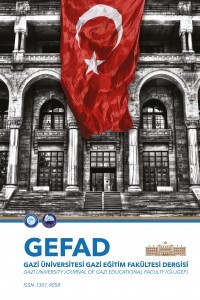İNGİLİZCE ÖĞRETMENLİĞİ PROGRAMINDA STANDART DEĞERLENDİRME VE ALTERNATİF DEĞERLENDİRME
İkinci/yabancı dil olarak öğretildiği ortamlarda İngilizce\'nin sınıf-temelli değerlendirilmesi, alanyazında son zamanlarda yer almaya başlamıştır. Yabancı dil öğretiminde değerlendirmenin önemine rağmen, üniversite düzeyinde yabancı dil öğretiminde farklı değerlendirme yöntemleri konusundaki araştırmalar sınırlı sayıda olmuştur. Bu çalışmada, İngilizce Öğretmenliği Programındaki öğrencilerin çoktan seçmeli bir sınavdan, bir sözlü sunumdan, ve bir çeviri görevinden aldıkları puanlar incelenmekte; çoktan seçmeli sınavdan en yüksek notu alan on öğrenciyle, en düşük notu alan on öğrencinin iki alternatif değerlendirme aracındaki başarı düzeyleri karşılaştırılmaktadır. Öğrencilere bir çoktan seçmeli test, bir çeviri görevi, ve de bir sözlü sunum görevi verilerek, öğrencilerin şu noktalarda düzeyleri değerlendirilmiştir: yabancı dilde bilgi tanıma, bilgi aktarımı ve bilgi uygulaması. Çoktan seçmeli sınavdan en yüksek notu alan on öğrenciyle, en düşük notu alan on öğrenci seçilmiş olup, bu öğrencilerin sunum ve çeviriden aldıkları puanlar çoktan seçmeli testten aldıkları puanlarla karşılaştırılmıştır. Bulgular, İngilizce öğrenenleri yalnızca bir araçla değerlendirmenin nesnel olmayabileceğini, ve değerlendirme araçlarının çeşitlendirilmesinin faydalı olacağını ortaya koymaktadır. Eğer değerlendirme yalnızca çoktan seçmeli test yoluyla yapılmış olsaydı, test tekniğine yatkın olan öğrenciler bundan daha fazla yararlanmış olacaktı, ve test tekniğine yatkın olmayan öğrenciler yanlış değerlendirilmiş olacaktı. Muhtemeldir ki üç araçtan elde edilen puanların ortalaması alınarak adalet ve geçerlilik neredeyse gerçekleştirilmiş oldu, ve de öğrencilerin farklı becerileri ve bilgi alanları değerlendirmede dikkate alındı.
Anahtar Kelimeler:
yabancı dil eğitimi, dil değerlendirmesi, standart testler, alternatif değerlendirme
STANDARD ASSESSMENT AND ALTERNATIVE ASSESSMENT IN ENGLISH LANGUAGE TEACHING PROGRAM
Classroom-based assessment practices within English as Second/Foreign Language (ESL/EFL) contexts have started to appear in the literature. Despite the importance of assessment in FL teaching, studies on different assessment methods at college level FL have remained limited. This study investigates the assessment in an elective course and aims to analyze the scores obtained through a standard assessment tool and two alternative assessment tools. It makes a comparison and contrast between the success levels of ten highest multiple-choice test scorers and ten lowest multiple-choice test scorers in two other tools. A multiple-choice test, a translation task and an oral presentation task were given to the participants to investigate whether there are differences in students\' levels of FL knowledge recognition, of FL knowledge transmission or pseudo-communication, and of FL knowledge application. Ten highest multiple-choice test scorers and ten lowest multiple-choice test scorers were chosen and their scores in oral presentation and translation were compared to their multiple-choice test scores. Results reveal that assessing EFL learners only through a single tool may not be objective, and that assessment tools should be diversified. If the assessment had been made only by means of the multiple-choice test, some test-wise students would have been favoured and some others would have been misassessed. It is likely that fairness and validity were almost realised by taking the average of the scores obtained through three tools, tapping different skills and knowledge areas of the students.
___
- Balliro, L. (1993). What kind of alternative? Examining alternative assessment. TESOL Quarterly, 27 (3), 558-561.
- Barootchi, N., & Keshavarz, M. H. (2002). Assessment of achievement through portfolios and teacher-made tests. Educational Research, 44 (3), 279–288.
- Braun, H. I., & Mislevy, R. (2005). Intuitive test theory. Phi Delta Kappan, 86 (7), 4894
- Brown, J. D., & Hudson, T. (1998). The alternatives in language assessment. TESOL Quarterly, 32(4), 653-675.
- Brown, J. D., & Hudson, T. (1999). The authors respond. TESOL Quarterly, 33 (4), 734-7
- Bruton, A. (1999). Comments on James D. Brown and Thom Hudson’s “the alternatives in language assessment” a reader reacts. TESOL Quarterly, 33 (4), 729-734.
- Cheng, L., Rogers, T., & Hu, H. (2004). ESL/EFL instructors’ classroom assessment practices: Purposes, methods, and procedures. Language Testing, 21 (3), 360– 3
- Council of Europe. (2001). Common European framework of reference for languages: Learning, teaching, assessment. Cambridge: Cambridge University Press.
- Edelenbos, P., & Kubanek-German, A. (2004). Teacher assessment: The concept of ‘diagnostic competence’. Language Testing, 21 (3), 259–283.
- Gottlieb, M. (2006). Assessing English language learners: Bridges from language proficiency to academic achievement. Thousand Oaks: Corwin Press.
- Henning, G. H., Ghawaby, S. M., Saadalla, W. Z., El-Rifai, M. A., Hannallah, R. K., & Mattar, M. S.(1981). Comprehensive assessment of language proficiency and achievement among learners of English as a foreign language. TESOL Quarterly, 15 (4), 457-466.
- House, J. (2006). Text and context in translation. Journal of Pragmatics, 38, 338-358. Hughes, A. (1990). Testing for language teachers. Cambridge: Cambridge University Press.
- Leung, C., & Lewkowicz, J. (2006). Expanding horizons and unresolved conundrums: Language testing and assessment. TESOL Quarterly, 40 (1), 211-234.
- Louma, S. (2004). Assessing speaking. Cambridge: Cambridge University Press.
- Lynch, B. K. (2003). Language assessment and programme evaluation. Edinburgh: Edinburgh University Press.
- ISSN: 1301-9058
- Yayın Aralığı: Yılda 3 Sayı
- Başlangıç: 1985
- Yayıncı: Gazi Üniversitesi
